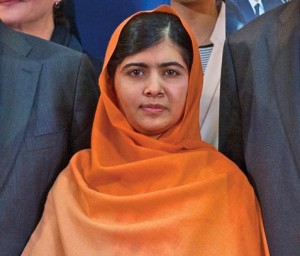
On November 20th of last year, the European Parliament awarded Malala Yousafzai (pictured right) the Sakharov Peace Prize for Freedom of Thought, the latest accolade presented to a young girl who has come to represent the struggle for female education, something still denied in many parts of the world.
The Pakistan teenager made headlines around the globe in October 2012 when she was shot by a would-be Taliban assassin on her way home from school. Malala had become an enemy of the Taliban thanks to her outspoken views on female education, writing a blog for the BBC and appearing in a New York Times documentary. After being transferred to a hospital in England, Malala pulled through, but both she and her father remain targets of the Taliban.
In 2008, the Pakistan region of Swat fell under Taliban influence and in January 2009 it became forbidden for girls to attend school. During this time, Malala was detailing her experiences on a blog hosted on the BBC website and featured in the documentary Class Dismissed. Over the next couple of years, Malala’s many media appearances raised her profile but also the ire of the Taliban, who had published death threats in local newspapers in the months before their assassination attempt.
The shooting sparked outrage worldwide, including her native Pakistan. The Taliban used the Quran to justify their actions, citing the Islamic holy text’s instruction that “even a child can be killed if he is propagating against Islam,” however Islamic clerics in Pakistan issued their own fatwa against the men responsible for the shooting. None of the perpetrators have yet been brought to justice.
Since her recovery, Malala has continued to campaign for female education. In Europe we may take it for granted but in many parts of the world, girls are denied what most would consider a basic human right.
A study by UNICEF found that 115 million children aged between six and twelve receive no education, with girls accounting for 63% of that figure. In developing countries, only 43% of girls attend secondary school. Religious and cultural beliefs are a large factor, with women still considered second-class citizens in many societies.
Economic hardship plays its part also. Forced to choose between paying for an education for their sons or daughters, parents in the developing world are most likely to opt for the former and young girls can often be sold into marriage. Even those fortunate to attend school can find themselves ignored by teachers who view their attendance as a waste of time or disapprove of it for cultural or religious reasons.
A study by the World Bank highlights the economic importance of an educated female population. Their findings show that a 1% increase of secondary educated females raises a nation’s annual per capita income by 0.3%. Girls with a secondary education are less likely to become pregnant as teenagers, a hugely important factor given the current crisis of over-population facing the developing world.
No teenage girl should have to take a bullet to highlight an issue, but Malala’s courage provides hope for the millions of girls denied an education. Facing thousands of years of ingrained intolerance, her task rivals that of Emmeline Pankhurst but she’s shown the world she’s up for a fight.
Image: Wikipedia.
By Eric Hillis

